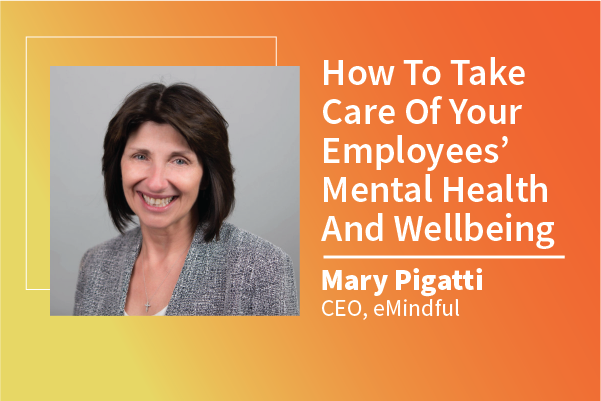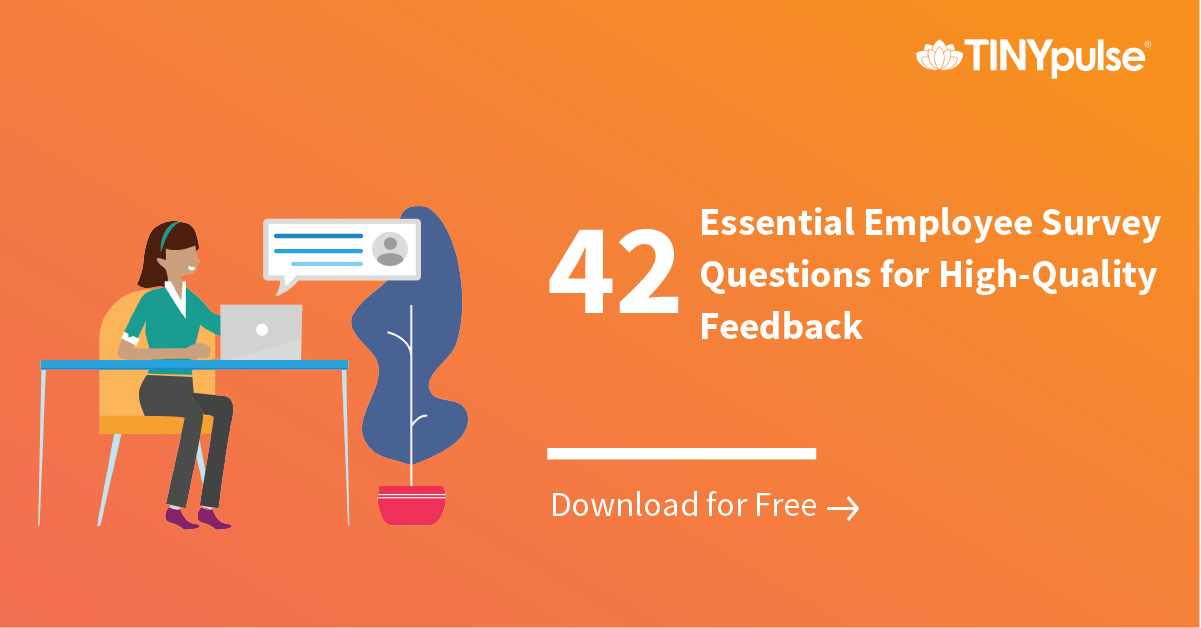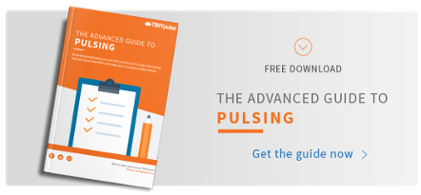The Only Workplace Wellness Survey Template You Need to Get Real Insights
Are your employees’ healthcare expenses hurting your organization?
Every year, poor employee health costs U.S. employers somewhere in the ballpark of an estimated $530 billion.
And that’s in addition to the $880 billion spent on health care benefits.
If the name of the game is creating a healthy and happy workplace and protecting profitability, something has to give.
Why Employee Health & Wellness Is Important
The true cost of employee health goes far beyond health insurance expenses.
1. Poor employee health leads to lower engagement levels
Your organization’s level of employee engagement is directly tied to the health and wellness initiatives you offer your team. Even just the perception that you care can affect engagement.
Research has shown that when employees believe their organization cares about their health and well-being, they are 38% more engaged.
When your employees are engaged, your company benefits tremendously.
2. Most absenteeism is tied to employees’ health
According to the Society of Human Resource Management (SHRM), personal illness and stress account for 47% of all absenteeism.
That’s more than double the amount of absenteeism caused by other reasons—such as family issues or personal needs. The SHRM also found that many of these medical-related absences could have been prevented.
When our employees miss work, our teams and companies pay the price. In addition to the leave paid out, this can also cause additional expenses in the form of increased overtime or the costs associated with taking on a temporary employee.
3. Poor employee health can decrease productivity
Even if our workers don’t take leave when they’re unwell, productivity is still impacted by presenteeism.
It’s hard to work while we’re in pain or uncomfortable. Employees with a chronic illness, injury, or sickness often experience decreased productivity because they aren’t able to focus on their work, even if they are putting the hours in.
READ MORE: HOW TO HACK PRODUCTIVITY WHILE WORKING FROM HOME -- 8 HELPFUL TIPS
4. Employee burnout is real—especially with remote work and COVID-19
TINYpulse research found burnout is one of the top 10 employee concerns about COVID-19.
Right now, our employees are being pulled in every direction. Work-life balance is more challenging than ever and stress levels are at an all-time high. Many of our employees are also worried about catching COVID-19.
Our employees' physical and mental health alike can put them at risk for burnout. By focusing on burnout drivers like these, we can help our employees be happier at work and more engaged.
The 7 Dimensions of Employee Health & Wellness
Let’s take a step back: How do we define “employee health and wellness” in the first place?
We know it’s about more than just our physical health—although this certainly influences it.
But what does it mean to be “well” or “healthy”?
After reviewing research, articles, and perspectives’ from many health and wellness experts, TINYpulse has identified seven primary dimensions of employee wellness:
- Emotional well-being
- Environmental wellness
- Intellectual well-being
- Occupational well-being
- Physical health
- Social well-being
- Spiritual wellness
By monitoring our employees’ well-being in each of these dimensions, we can better understand the challenges they are facing and adapt our health and wellness programs to better support them.
Employee Health and Wellness Survey Question Template
An employee well-being survey, or employee health and wellness survey, is more than a general health and wellness assessment.
It’s designed to get your employees to reflect on habits, actions, and feelings for each dimension of wellness.
Here is an employee health and wellness survey template you can use to learn more about your employees’ well-being in wake of COVID-19.
Employee survey questions about general employee wellness
How much do you agree with the following statement:
1. Overall, I feel well and whole (emotionally, physically, etc.).
1 being strongly disagree, 5 being strongly agree
As an opening question, this general employee wellness survey item will help you see the big picture. It will help you understand how your employees feel about their health.
Employee survey questions about employees’ emotional well-being
How much do you agree with each of the following statements:
1. I feel emotionally strong and resilient.
1 being strongly disagree, 5 being strongly agree
2. I find it easy to express my emotions in positive, constructive ways.
1 being strongly disagree, 5 being strongly agree
3. I am resilient and can bounce back after a disappointment or problem.
1 being strongly disagree, 5 being strongly agree
4. I am flexible and adapt to change in a positive way.
1 being strongly disagree, 5 being strongly agree
5. I am able to recognize and manage the things that cause me stress.
1 being strongly disagree, 5 being strongly agree
6. I love and accept myself for who I am.
1 being strongly disagree, 5 being strongly agree
Although sometimes overlooked, emotional well-being is just as important as our physical health.
Emotional distress often leads to exhaustion and stress. And that’s a problem, since stress often leads to sleep deprivation, decreased productivity, and burnout.
In fact, almost two-thirds of workers in America are ready to quit their job due to stress.
By asking your employees about factors that can affect their emotional well-being, you can see how your workforce is adapting to the almost daily changes that affect them.
If you score low in this wellness dimension (which is very common), a mental wellness initiative may be a good place to start. And remember, it doesn’t have to be expensive to be effective.
An easy way to start is to begin curating existing resources about resilience, stress-relief methods, and more.
For example, the CollegeofWellbeing.com offers a free resilience training, and the Sanvello app teaches ways to deal with anxiety, depression, and stress.
By leveraging what’s already available, you can help your employees increase their emotional well-being and overall wellness.
Employee survey questions about environmental wellness
How much do you agree with each of the following statements:
1. I am in a comfortable environment (work and home).
1 being strongly disagree, 5 being strongly agree
2. I recognize the impact of my actions on my work and home environment.
1 being strongly disagree, 5 being strongly agree
3. I recognize the impact of my home and work environment on my health.
1 being strongly disagree, 5 being strongly agree
4. I contribute toward making my home and work environment a safer and healthier place.
1 being strongly disagree, 5 being strongly agree
5. I live in a safe environment.
1 being strongly disagree, 5 being strongly agree
6. I spend time outdoors enjoying nature.1 being strongly disagree, 5 being strongly agree
When’s the last time you thought about how your environment affects your health?
For most of us, we don’t always recognize the impact our surroundings can have on us.
A “healthy” environment is one where we feel safe, comfortable, connected to nature. In turn, we are mindful of the impact our actions have on such an environment.
Our environment can affect both our physical and emotional health. But when we understand the impact our actions have, we feel more empowered and gain a sense of control.
If your scores are lower in the environmental wellness dimension (in particular with questions 1 through 4), try to dig in more. Send a follow-up employee survey and ask your employees more about their work environment.
Do they have access to ergonomic office chairs, desks, and other appropriate office furniture or are they working off their kitchen counter? Do they have a way to provide feedback about their work environment?
FREE DOWNLOAD: 9 EMPLOYEE SURVEY TEMPLATES THAT ARE PROVEN TO DRIVE BETTER LEADERSHIP DECISIONS.
The goal is to learn what you can do to help create a better work environment.
Employee survey questions about employees’ intellectual well-being
How much do you agree with each of the following statements:
1. I am intellectually stimulated by my work and non-work activities.1 being strongly disagree, 5 being strongly agree
2. I can critically consider the opinions and information presented by others and provide constructive feedback.1 being strongly disagree, 5 being strongly agree
3. I feel capable of making important decisions.
1 being strongly disagree, 5 being strongly agree
4. I keep informed about social, political and/or current issues.1 being strongly disagree, 5 being strongly agree
5. I look for ways to use my creativity and critical thinking skills.1 being strongly disagree, 5 being strongly agree
6. I seek personal growth by learning new skills.1 being strongly disagree, 5 being strongly agree
Intellectual wellness is about stimulating and challenging our mind.
Employees who have a higher level of intellectual wellness are more likely to be engaged in their work and often have a learning mindset. They are also more adaptable and open to change.
If your health and wellness survey shows lower results in this dimension, try to find ways to engage your employees. Give them opportunities to challenge themselves intellectually.
This might mean drilling deeper to find out what opportunities your employees need most. Consider conducting a follow-up employee growth and development survey to learn more.
Employee survey questions about occupational wellbeing
How much do you agree with each of the following statements:
1. My work is personally satisfying.
1 being strongly disagree, 5 being strongly agree
2. I get personal satisfaction and enrichment from work.
1 being strongly disagree, 5 being strongly agree
3. My workload is manageable.
1 being strongly disagree, 5 being strongly agree
4. I am content with where I am in my career.
1 being strongly disagree, 5 being strongly agree
5. I am developing the necessary skills to achieve my career goals.
1 being strongly disagree, 5 being strongly agree
6. I balance work with play and other aspects of my life.
1 being strongly disagree, 5 being strongly agree
Occupational wellness refers to how your employees feel about their work. Our employees want to be able to use their skills to contribute in a meaningful way.
Surveying your employees about their work-life balance, goals, and other aspects about their job can help you better understand your employees’ attitude about work.
When employees’ have strong occupational well-being, they are less likely to be stressed. Occupational wellness has also been linked to better on-the-job performance.
When you analyze your survey results for this dimension, try to look for themes.
For example, if questions four and five both score low, it may be a good idea to look at the career development opportunities you have available. On the other hand, if questions three and six score low, workload and boundaries may take precedent.
Employee survey questions about workers’ physical health
How much do you agree with each of the following statements:
1. I generally feel very good about my health.1 being strongly disagree, 5 being strongly agree
2. I exercise at least three times a week.1 being strongly disagree, 5 being strongly agree
3. I protect myself and others from getting ill (e.g., wash my hands, cover my cough, etc.).1 being strongly disagree, 5 being strongly agree
4. I get enough sleep and feel vibrant throughout the day.1 being strongly disagree, 5 being strongly agree
5. I listen to my body; when there is something wrong, I seek needed assistance.1 being strongly disagree, 5 being strongly agree
6. I maintain healthy eating habits.1 being strongly disagree, 5 being strongly agree
How physically healthy are your employees?
Physical wellness consists of a variety of individual behaviors such as exercise, sleep, and nutrition. Our lifestyle choices can either positively or negatively impact our physical health which, in turn, can affect other wellness dimensions.
If you notice lower survey results for these questions, it may be time to start exploring employee health and wellness programs. If you already have one in place, use your results to make improvements to your program.
Employee survey questions about social well-being
How much do you agree with each of the following statements:
1. I have a healthy social life.1 being strongly disagree, 5 being strongly agree
2. I feel supported and respected in my close relationships.1 being strongly disagree, 5 being strongly agree
3. I participate in a variety of social activities.1 being strongly disagree, 5 being strongly agree
4. I am able to maintain healthy relationships with my friends and loved ones.1 being strongly disagree, 5 being strongly agree
5. I feel a sense of belonging to a group or community.1 being strongly disagree, 5 being strongly agree
6. I have someone I can talk to about my private feelings.1 being strongly disagree, 5 being strongly agree
Do your employees have strong personal and professional relationships?
Social well-being describes how well we interact with those around us and the strength of the relationships we build. In wake of COVID-19, it’s more important than ever to focus on social wellness.
If your results in this dimension are lower than others, consider implementing virtual team-building activities. You can also provide your employees with resources for forming connections outside of work.
Employee survey questions about employees’ spiritual wellness
How much do you agree with each of the following statements:
1. My life has purpose.1 being strongly disagree, 5 being strongly agree
2. I take time to think about what’s important in life—who I am, what I value, where I fit in, and where I am going.1 being strongly disagree, 5 being strongly agree
3. I have found a balance between meeting my needs and those of others.1 being strongly disagree, 5 being strongly agree
4. I engage in acts of caring and goodwill without expecting something in return.1 being strongly disagree, 5 being strongly agree
5. I feel like my life has purpose and meaning.1 being strongly disagree, 5 being strongly agree
6. I experience love, joy and fulfillment.1 being strongly disagree, 5 being strongly agree
Spiritual wellness encompasses our core beliefs and values that guide us.
It’s what brings purpose and meaning to our lives. For some, this includes religious beliefs. But contrary to popular belief, spirituality doesn’t always involve religion.
Given the current circumstances around COVID-19, many are unable to volunteer like they used to.
Our employees may also be so preoccupied by financial strain or health concerns that they aren’t able to focus on their spiritual wellness; Maslow’s Hierarchy of Needs comes to mind.
So, what can you do to improve your scores in this dimension?
First, make sure your other dimensions are covered so your employees are able to focus on their spiritual needs. Once these dimensions are taken care of, you can begin to work on the spiritual wellness dimension.
A spiritual wellness workplace initiative can take many forms.
Here are a couple of ideas to get you started:
- Company-wide fundraiser: Select a non-profit to support as a company. You can hold virtual fundraisers, ask employees to raise awareness on social media, or donate directly to the organization.
- Training: There are many great free training sessions available (like the one offered by the University of Michigan) to help your employees learn to find purpose and meaning. See what’s out there and share these resources with your employees.
- Journaling: Daily journaling can help your employees gain a better perspective on their life. Encourage your employees to spend up to 10 minutes journaling each day and share resources on how to get started.
Employee survey questions to ask about burnout risk
How much do you agree with each of the following statements:
1. Most days I feel burned out.1 being strongly disagree, 5 being strongly agree
2. I have negative thoughts about my job.1 being strongly disagree, 5 being strongly agree
3. I feel misunderstood or unappreciated by my co-workers.1 being strongly disagree, 5 being strongly agree
4. I feel that I am not getting what I want out of my job.1 being strongly disagree, 5 being strongly agree
5. I am easily irritated by small problems, or by my co-workers and team.1 being strongly disagree, 5 being strongly agree
6. I feel emotionally drained often.1 being strongly disagree, 5 being strongly agree
Employee burnout can be influenced by each of the seven dimensions of wellness. If your employees are struggling in one or more areas, they may be at risk for burnout.
If your employee survey results indicate your employees are at risk for burnout, carefully analyze your results for each dimension. Focusing on making improvements in these areas can help reduce stress and prevent employee burnout.
Open text survey questions about general employee wellness
1. Overall, how do you feel about your health and wellness? _______________
2. Do you feel our organization contributes positively to the health and wellness of our people? _____________________________________________
By asking your employees about each dimension of wellness, both you and your team will gain more insight into their overall health and wellness.
These two final open-ended questions will help your employees reflect on their wellness. It will also help you see how well they perceive your company supports their health and wellness efforts.
These insights can help you analyze the rest of your survey results and prioritize interventions.
How do you support your employees' health and wellness?
Improving employee health and wellness is an investment that pays off.
From increased productivity and engagement to lower absentee rates, employee wellness is one of the most valuable investments we can make.
As leaders, our employees need to know we care about their well-being.
An employee well-being survey can help understand the challenges your team is facing and identify solutions to support them.
Even a simple one-on-one check-in can go a long way toward supporting your employees’ emotional, social, and occupational well-being.
Here’s the building a healthier, better balanced team that’s well-positioned to reach its full potential.
Share this
You May Also Like
These Related Stories









.png?width=534&height=632&name=blog%20ad%20(1).png)
